 Technology peripherals
Technology peripherals
 AI
AI
 Eight major technological innovations in the history of smart home development
Eight major technological innovations in the history of smart home development
Eight major technological innovations in the history of smart home development
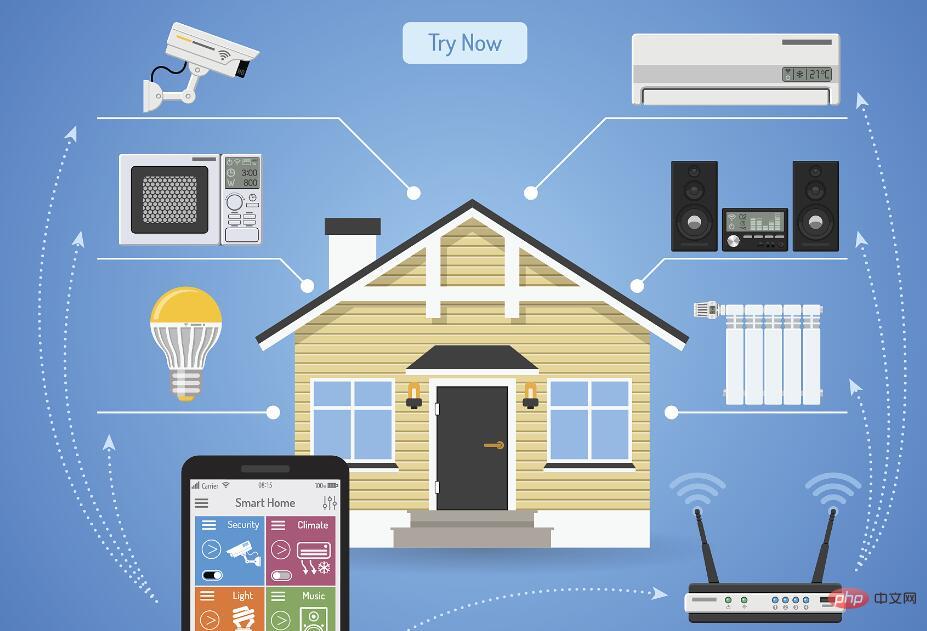
Nowadays, with the widespread application of smart devices represented by smart speakers, more and more People already feel that the home of the future seems to have arrived. We can speak into the air and magically turn on music, set a timer, or listen to the weather report. The tiny supercomputers in our pockets, like smartphones, can lock our doors, set our alarm clocks, and dim our lights to the right brightness at the touch of a button.
It is only in the past ten years or so that smart homes have really attracted the attention of mass consumers. However, today’s smart homes have gone through a long period of time before technological upgrades. Some people may question whether they are Really that smart. In fact, applying automation to home life has a long history.
When Home Appliances Became Automated
Home electrification in Europe and North America began to spread in the late 19th and early 20th centuries, making the birth of the first home appliances possible. By 1925, about half of American households had electricity, and by the 1930s, two-thirds of British households had electricity.
By the mid-20th century, refrigerators, washing machines and vacuum cleaners, common household appliances we have today, have been widely used in the United States.
Although commercial refrigerators have been around since the 1850s, the first home refrigerator was not introduced until 1911. Home refrigerators didn't really take off until 1927, when GE introduced the "monitor-top" refrigerator, a design that combined the compressor and cold box into a single unit. It got its name because the compressor located on top of the unit was thought to resemble the gunwale on a battleship monitor. Even so, the refrigerator is still a bit unfriendly. In 1927, the Monitor Top sold for $525, which was a lot of money at the time.

Image source ##University of Buffalo
With the invention of Freon in 1928, home refrigeration achieved another major leap. Refrigerators began to gain widespread adoption in the 1930s. At the beginning of the 20th century, only 8% of American households owned one. By the late 1940s, refrigerators had become a common standard feature in American homes. The exact inventor of the electric washing machine is disputed, but the Automatic Electric Washer Co. began manufacturing early washing machines in 1907. However, it wasn't until the 1950s that they became a staple of the average American home.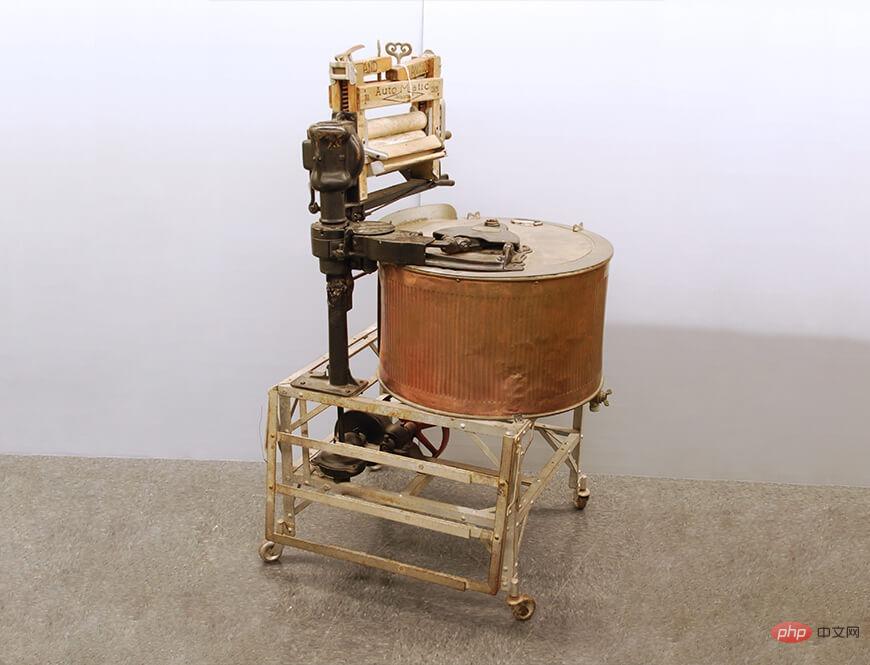
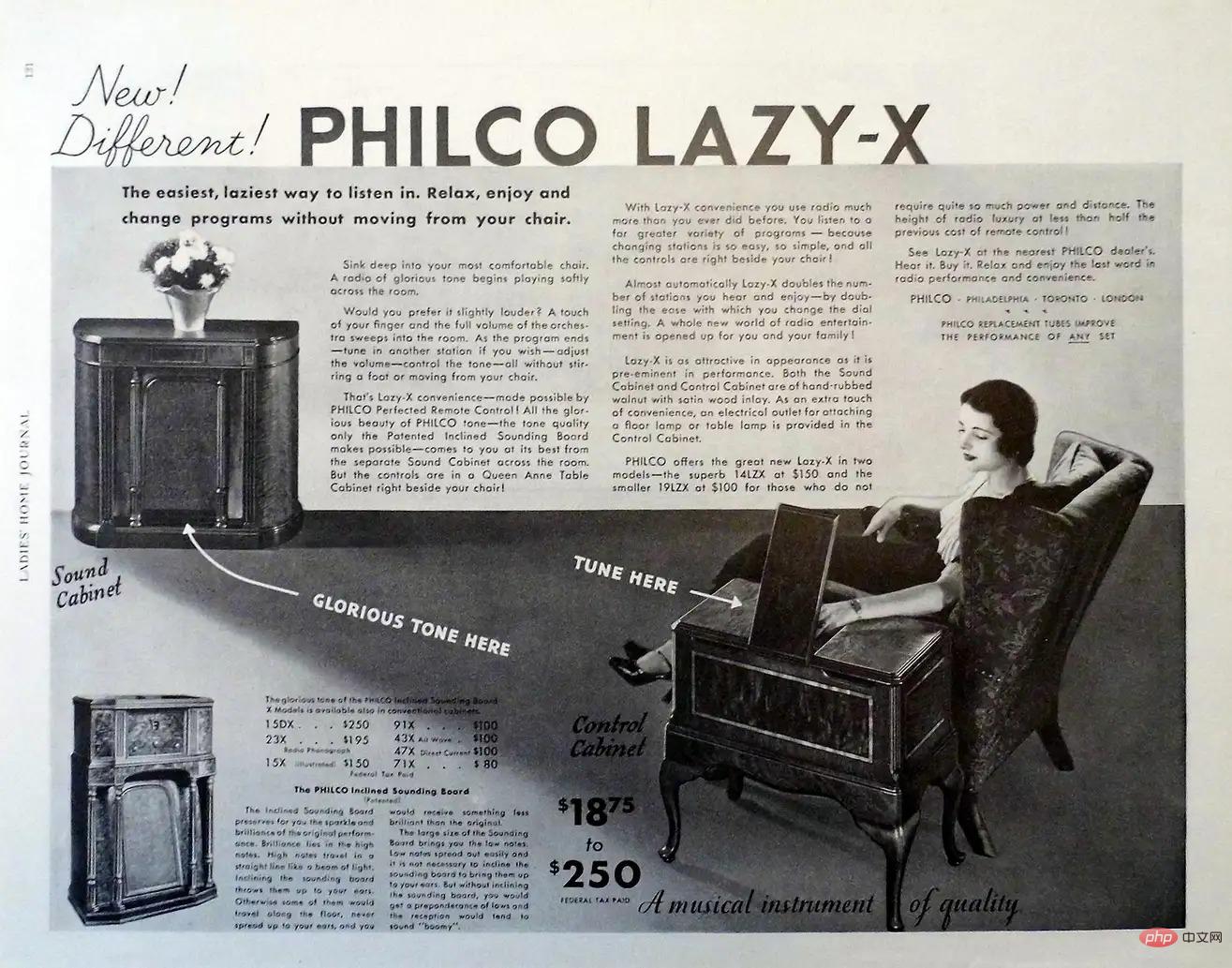
Picture source: Joe Haupt
Another example, the picture above is an early one that can sit Advertisements for "remotely" controlling music playback equipment on chairs can help people control radios more conveniently. The birth of the remote controlThe idea of a remote control existed long before remote controls were widely placed on the table in each of our homes. In 1893, inventor Nikola Tesla demonstrated a device that could send and receive radio signals in front of the National Electric Light Association in St. Louis. This device is not intended for home use, but for military applications. At the 1898 Electrical Exhibition in New York, Tesla successfully demonstrated a radio-controlled boat.In the 1940s, devices that automatically opened and closed garage doors were invented, and remote controls became a feature in the home. But it wasn't until 1950 that the first television remote control was manufactured by Zenith Radio Corporation. Dubbed the "lazy bone," the device can turn the TV on and off and switch channels, although it requires a physical cable to operate. In 1955, Zenith debuted the "Flash-matic", the first wireless television remote control.
Remote controls became a feature of the home in the 1940s when devices were invented to automatically open and close garage doors. But it wasn’t until 1950 that the first television remote control was manufactured by the Zenith Radio Corporation. Dubbed the "Lazy Bone," the device can turn your TV on and off and switch channels, but it requires a physical cable to operate. In 1955, Zenith launched the first wireless TV remote control "Flash-matic".

At that time, the remote control used visible light, which was actually a flashlight. The core of the remote control was to illuminate four different receiving areas on the four corners of the TV to complete the forward movement. Channel change, backward channel change, mute and power switch functions. However, it is recognized in the industry that the popular infrared remote control is still inspired by "Flash-Matic" and mixed with Space Command's command encoding transmission method.
The birth of the first smart home computer
ECHO IV marks the invention of the first true smart home device. Invented by James Sutherland of the Westinghouse Electric Company, the giant computer consisted of four cabinets, took up an entire room, and weighed 800 pounds.
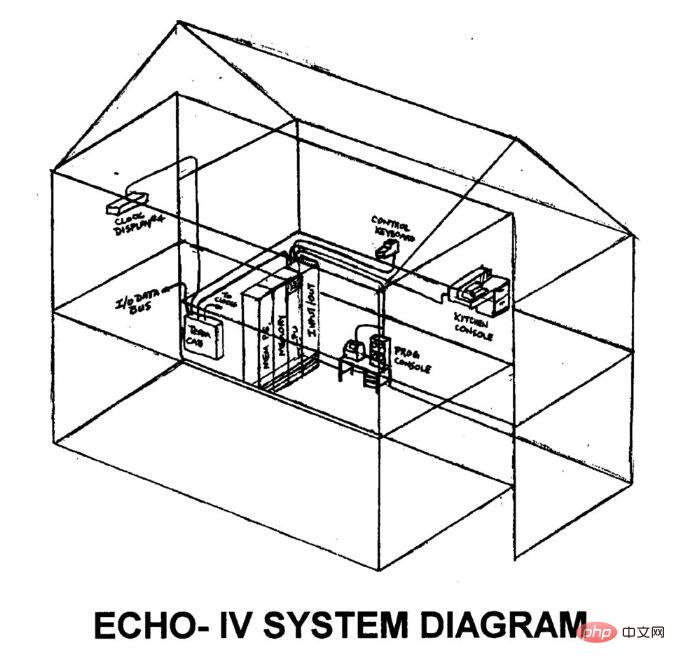
Sutherland designed it to be fully integrated into the home, placing keypads and control panels in different rooms to control various functions. ECHO IV, which has been running for ten years, can control televisions, alarm clocks, stereos, thermostats, air conditioners, and even record family finances.
While not commercially available, Sutherland's invention was an impressive piece of smart home technology that preceded similar devices by decades.
The first cooking app
Just a few years after the release of the ECHO IV, engineering giant Honeywell has launched a kitchen computer that promises to make cooking easier. This 16-bit kitchen computer is capable of storing recipes and comes with multiple pre-programmed programs.
When people think of computer hardware, they usually think of monitors, keyboards, or printers. Well, a kitchen computer might have the weirdest piece of “hardware” I’ve ever heard of – a cutting board. Yes, a cutting board! You read that right. And, it weighs an astonishing 150 pounds.
Kitchen computers are obviously designed for housewives who like to cook. However, any housewife who wanted this tool would have to spend a lot of money, considering the kitchen computer cost $10,600 when it was first introduced (remember, in 1965, you could buy about four new cars for that much money!) . But I will give you gifts, including a cookbook and an apron (don’t you laugh).
Because of this, this kitchen computer did not become popular quickly. Its novelty and quirky design may put off consumers, but it's also likely that its price tag will turn off interested parties. As you might expect, none of the device sold, but its concept was ahead of its time and may have paved the way for some of the weirder products on the market today.
For example, a frying pan that detects what’s inside, a toothbrush that “teaches” you how to brush through an app, a fork that records how fast you eat, a wearable that tells you when you’re stressed Devices, a plastic box that tells you if you need more eggs, a bottle that keeps track of how much water you drink, a yoga mat that tells you when you're doing a wrong move, a monitor that tells you when a tampon is full, Skipping ropes with built-in LEDs that display fitness data during workouts, wine bottles with Wi-Fi support... don't laugh! These things really exist!
X10 Protocol Finds a Way to Connect
In 1975, a real game-changer for smart home devices emerged with the development of X10. Communication protocols enable smart devices to communicate with each other for the first time ever. The technology was invented in the 1970s by a team of engineers at Pico Electronics in Glenrothes, Scotland, and relies on a home's AC wiring to operate. Since then, new technologies have opened up the ability to connect multiple devices together in the home.
Soon, X10 became the industry standard, first entering the U.S. market in 1978 in partnership with RadioShack. This protocol is used to operate RadioShack's signature "Plug and Play" devices and Sears "Home Control Systems." Although, X10 was not a perfect system—it could be slow, unstable, and lacked encryption—it paved the way for the contemporary smart home market.
The rise of the Internet of Things (IoT)
Time continues to move forward, and the smart home device market has made great progress. Throughout the 1980s, products like motion-sensor lights and programmable home security systems became mainstream. In 1984, the National Association of Home Builders coined the term "smart house."
When the 1990s arrived, a new concept called "Internet of Things" (IoT) emerged. The idea is that objects can contain the ability to transmit and receive data over a network. In 1990, computer scientists John Romkey and Simon Hackett teamed up to build the first IoT device in the form of a connected toaster. However, the term was not coined until 1999 by computer scientist Kevin Ashton.
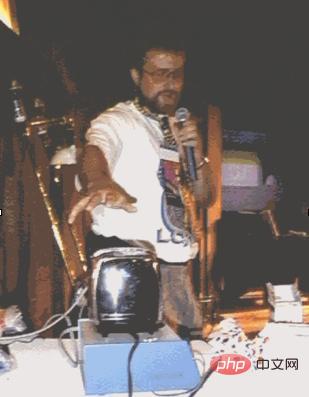
Hackett Showcase Toaster
This toaster works over TCP /IP networks connect to the Internet and are controlled through the Simple Network Management Protocol Management Information Base (SNMP MIB). It only has one control, which is to turn the power on, and the color of the toast is controlled by how long the power is on.
WiFi was invented in 1997. Other wireless protocols such as Bluetooth, Z-wave and ZigBee also emerged in the 1990s and were refined in the early 2000s. These network protocols broaden the possibilities and diversity of smart devices. Microsoft's Smart Home Vision, released in 1999, predicted many of the future features of the contemporary smart home, such as touchscreen panels, push notifications sent to handheld devices, and even retinal scanners for opening doors. These features are now widely used.
Smart speakers enter the market
In the 2010s, large technology companies such as Amazon, Google, and Apple began competing to create the next big smart device to capture the market.
In 2014, Amazon launched the familiar smart speaker Echo and controlled it through its smart voice assistant Alexa, which immediately caused a sensation in the industry. That same year, Apple released HomeKit, an all-in-one app that can control different functions in your home from a device such as an iPhone or iPad. Google launched Google Home, a smart speaker with a built-in voice assistant, in 2016 to compete head-on with Amazon. At present, except for Apple's HomeKit, which is relatively weak, Amazon and Google are both developing well.
The artificial intelligence revolution has arrived...
The future has arrived, but smart homes are not yet truly smart. (See: Qianjia Viewpoint: Why are smart homes not smart enough? )
The current smart home field still faces many problems, including privacy, security and interoperability. A world of connected IoT devices has become a reality, but it doesn’t operate as seamlessly as people imagine, nor does it necessarily bring convenience to people’s lives.
However, the market is growing. According to Statista, an estimated 130 million households worldwide have smart devices, and the smart home market is expected to be worth nearly $223 billion by 2027.
The next innovation coming to smart devices is the integration of language models (such as ChatGPT) with virtual assistants. An American company, Josh.ai, is already using the technology to build its own assistant. Last year, Amazon announced it was developing a large-scale language model that could be used to improve Alexa. If successful, smart homes could reach a whole new level of intelligence. The key question is whether consumers and even technology innovators are ready for it. Or even want it.
The above is the detailed content of Eight major technological innovations in the history of smart home development. For more information, please follow other related articles on the PHP Chinese website!

Hot AI Tools

Undresser.AI Undress
AI-powered app for creating realistic nude photos

AI Clothes Remover
Online AI tool for removing clothes from photos.

Undress AI Tool
Undress images for free

Clothoff.io
AI clothes remover

AI Hentai Generator
Generate AI Hentai for free.

Hot Article

Hot Tools

Notepad++7.3.1
Easy-to-use and free code editor

SublimeText3 Chinese version
Chinese version, very easy to use

Zend Studio 13.0.1
Powerful PHP integrated development environment

Dreamweaver CS6
Visual web development tools

SublimeText3 Mac version
God-level code editing software (SublimeText3)

Hot Topics
 1386
1386
 52
52
 No.9 electric vehicle mechanic MMAX2 released: starting from 7999 yuan
Aug 23, 2024 am 06:59 AM
No.9 electric vehicle mechanic MMAX2 released: starting from 7999 yuan
Aug 23, 2024 am 06:59 AM
On August 22, Nine Company, my country's leading smart two-wheeled electric vehicle company, released three series of multiple new two-wheeled electric vehicle products at once, including both new product series and upgraded products of existing series. The many new products released by No.9 Company this time have been almost fully upgraded to "top-of-the-line" products from configuration, design to intelligence. In addition to iterative upgrades on the product side, Nine Company has also made a lot of layout and optimization in the whole sales process services. In addition to increasing offline pure after-sales outlets, Nine Company will also build a national rapid energy replenishment network. In recent years, my country's two-wheeled electric vehicle market has reached a stage of high-quality development, and consumer demand for two-wheeled electric vehicles has become diversified and "high-end." Correspondingly, on the supply side, the competition between brands has also transitioned from the previous pure "volume price" to
 Realme launches 320W super-light speed second charge
Aug 14, 2024 pm 06:46 PM
Realme launches 320W super-light speed second charge
Aug 14, 2024 pm 06:46 PM
On August 14, the Realme mobile phone made the world's first flash charging black technology - 320W super-light speed charging, marking another revolutionary leap in mobile phone flash charging speed, and China's technology once again leads the world! Realme's 320W super-light speed charging has achieved unprecedented breakthroughs in terms of power, safety and efficiency. It not only pushes the industry's flash charging technology to a new height, but also brings a new flash charging experience to users. 320W super-light speed second charging, a miraculous experience of 4 minutes and 30 seconds. 320W super-light speed second charging technology breaks the limit of charging speed again. It only takes 4 and a half minutes to charge a 4420mAh mobile phone battery to 100%, which is faster than the previous 240W. Flash charging technology once again improves charging efficiency. Behind this achievement is actually the combination of "high power, high safety and miniaturization"
 Wenjie's new M7 Pro is officially launched with prices starting at NT$249,800, equipped with the basic version of HUAWEI ADS
Sep 02, 2024 pm 12:34 PM
Wenjie's new M7 Pro is officially launched with prices starting at NT$249,800, equipped with the basic version of HUAWEI ADS
Sep 02, 2024 pm 12:34 PM
On August 26, Hongmeng Smart held a new product launch conference. Its three major brands, AITO, LUXEED and STELATO, were unveiled with a number of blockbuster new cars. At the press conference, Wenjie's new M7 Pro was officially launched, priced at 249,800-289,800 yuan. It is equipped with the HUAWEIADS basic version of the intelligent driving assistance system, ushering in a new era of intelligent driving for all. Yu Chengdong, Huawei’s Managing Director, Chairman of Terminal BG, and Chairman of Smart Car Solutions BU, said: “Wenjie’s new M7 Pro has the largest space, the best driving control, the strongest intelligent driving and the strongest safety in its class. It is the best in the 250,000 class. SUV! will bring users a more extreme travel experience and help the sales of Hongmeng Zhixing family continue to increase. "Extraordinary space, ever-changing magic comfortable seats."
 Hongmeng Zhixing Wenjie's new M7 Pro was officially released, and its first coupe SUV, Zhijie R7, was unveiled on the same stage
Sep 02, 2024 pm 01:40 PM
Hongmeng Zhixing Wenjie's new M7 Pro was officially released, and its first coupe SUV, Zhijie R7, was unveiled on the same stage
Sep 02, 2024 pm 01:40 PM
On August 26, Hongmeng held its first new product launch conference. Wenjie’s new M7 Pro was officially launched, with an official price of 249,800-289,800 yuan. At the same time, Hongmeng Zhixing’s first coupe SUV, the Zhijie R7, was officially unveiled. Yu Chengdong, Huawei’s Managing Director, Chairman of Terminal BG, and Chairman of Smart Car Solutions BU, said: “Wenjie’s new M7 Pro has the largest space, the best driving control, the strongest intelligent driving and the strongest safety in its class. It is the best in the 250,000 class. "SUV!" will bring users a more extreme travel experience and help Hongmeng Zhixing continue to increase sales." At the press conference, Hongmeng Zhixing handed over the latest answer: AITO Wenjie delivered 400,000 vehicles in 2 years and 5 months, creating a smart luxury brand. New record. Gaoyan’s urban performance SUV Wenjie’s new M5 has been delivered with over 20,000 deliveries
 Geely's new pure electric car 'Xingyuan' official image released: equipped with Flyme Auto vehicle system
Sep 02, 2024 pm 01:10 PM
Geely's new pure electric car 'Xingyuan' official image released: equipped with Flyme Auto vehicle system
Sep 02, 2024 pm 01:10 PM
DoNews reported on September 2 that Geely Automobile today released the official image of its new pure electric car "Xingyuan". The car will be equipped with the FlymeAuto vehicle system and is expected to compete with BYD Dolphin and other models after its launch. The car adopts a round and lovely styling style, with smooth lines and a full and smooth overall outline. It adopts a dual-color body. Its length, width and height are 4135/1805/1570mm respectively, and the wheelbase is 2650mm. The official released the cockpit design of the new car this time. The interior of the new car also uses a large number of curves, echoing the agile appearance of the exterior. It is equipped with a suspended central control screen, a two-spoke steering wheel, and decorative panels on the doors and in front of the passenger seat. It is embellished with an outline drawing that resembles a group of urban high-rise buildings. The car will be built based on a new pure electric platform.
 Global terminal sales of SAIC Passenger Vehicles exceeded 477,000 units from January to July, a year-on-year increase of over 12%
Aug 12, 2024 pm 06:42 PM
Global terminal sales of SAIC Passenger Vehicles exceeded 477,000 units from January to July, a year-on-year increase of over 12%
Aug 12, 2024 pm 06:42 PM
In July 2024, global terminal sales of SAIC's dual-brand passenger cars exceeded 59,000 units; from January to July, global cumulative terminal sales exceeded 477,000 units, a year-on-year increase of more than 12%. The industry's highest "Super Safety Commitment" pays one for every burn, and the lifetime warranty of three electric vehicles follows the car but not others. With a deep insight into the pulse of the market and an accurate grasp of consumer needs, on July 4, SAIC Passenger Cars officially launched the industry's highest The standard "Super Safe Core Commitment" sets a new industry benchmark for battery zero-combustion guarantee with a service standard of paying new cars within 20 working days. At the same time, it is announced that the lifetime warranty of three electric vehicles is not limited to the first car owner and annual driving mileage, providing users with Provides comprehensive security and worry-free experience. This move goes beyond the current warranty standards of mainstream car companies and bids farewell to the 30,000-kilometer warranty commonly used in the industry.
 Haopin Quark electric drive 2.0 rolls off the production line: speed 30000rpm / motor efficiency 98.5%
Aug 23, 2024 pm 03:41 PM
Haopin Quark electric drive 2.0 rolls off the production line: speed 30000rpm / motor efficiency 98.5%
Aug 23, 2024 pm 03:41 PM
On August 23, the Haopin Quark electric drive 2.0, which is based on mass production of amorphous alloys, rolled off the production line at Ruipa Power Technology Co., Ltd. With the world's highest mass-produced motor efficiency of 98.5%, the world's highest mass-produced motor power density of 13kW/kg, and the world's highest mass-produced motor speed of 30,000 rpm, it ranks first in the world. It is reported that Haopin’s upcoming new model will have a cruising range that can be increased by 50km without adding a battery. Let every kilowatt hour of electricity go farther. The birth of the world's most efficient electric drive into mass production First, let's focus on the first global first of Quark Electric Drive 2.0 - mass production motor efficiency. The motor efficiency of up to 98.5% has infinitely approached the physical limit of 100% room temperature superconductivity, leaving many competitors behind. Next is the
 SAIC-Volkswagen's new SUV unveiled, Tuyue Xinrui sets new benchmark for A-class SUVs
Aug 21, 2024 pm 08:46 PM
SAIC-Volkswagen's new SUV unveiled, Tuyue Xinrui sets new benchmark for A-class SUVs
Aug 21, 2024 pm 08:46 PM
Recently, SAIC Volkswagen’s new SUV TharuXR was unveiled. The new car is positioned as an A-class SUV, and its Chinese name is Tuyue Xinrui. As a new warrior of the Tuyue family, it will join forces with the new Tuyue to accelerate its lead in the A-class SUV market with new development momentum. Since the announcement of the Ministry of Industry and Information Technology’s declaration in June, Tuyue Xinrui has attracted widespread attention with its new-generation Volkswagen SUV design language and its class-leading, powerful and fuel-efficient 1.5TEVOII net-efficiency engine. This debut, along with the release of more model information, creates a new realm of fuel economy and durability, surprising the first batch of KOLs who experienced it. A KOL said: "The Tuyue Xinrui may be the most worth buying A-class SUV, and I am very much looking forward to its launch." You won’t get tired of the appearance for a long time. Tuyue’s cutting-edge appearance adopts Volkswagen’s new generation SU



